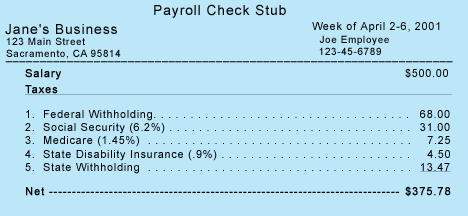Understanding Your Paycheck


As an employee, your paycheck and paycheck statement should look something like the examples above. An explanation of the amounts taken out of your check follows the paycheck statement.
In this case, Joe's filing status is single with zero exemptions. His withholding is calculated using the tax tables in the IRS Publication 15 and the EDD DE 44.
- Federal withholding is money that is withheld and sent to the IRS to pay federal income taxes. It goes to pay for a number of programs, such as national defense, foreign affairs, law enforcement, education, and transportation. Every year, the federal elected representatives meet to decide how this money will be spent.
- Social security is money set aside for a federal program that provides monthly benefits to retired and disabled workers, their dependents and their survivors.
- Medicare provides health care coverage for older Americans and people with disabilities.
- State Disability Insurance provides benefits to eligible workers experiencing a loss of wages when they are unable to perform their usual work because of pregnancy, nonoccupational illness or nonoccupational injury. Beginning January 1, 2004, SDI includes Paid Family Leave, which provides benefits to workers who need to care for a seriously ill family member or to bond with a new child.
- State withholding is money that is withheld and sent to the State of California to pay California income taxes. It pays for state programs such as education, health and welfare, public safety, and the court justice system. California's elected representatives also meet every year to decide how this money will be spent.
* Other items besides taxes that can be deducted from your paycheck include life insurance premiums and retirement plan contributions.
It's a good idea to keep each statement in a safe place. After the year is over, you will receive a Form W-2 (Wage and Tax Statement) from each employer showing the amount of your total earnings and withholdings for the year. If you question the amounts shown, you can go back and compare your paycheck statements to the W-2 totals. Contact your employer if you don't understand your statement or if your records don’t agree with the W-2.
Your First Job
Congratulations! It's exciting to have your first job - no matter what it is. There are a number of things you need to know as a potential taxpaying, hard-working individual.
- As a new employee, you will be asked to fill out a number of forms, including a Form W-4 and possibly a DE 4. These forms will determine how much income tax is withheld from your paycheck. You will receive a paycheck statement along with your check that shows the tax withheld and any other deductions.
- If your employer pays you in cash with no withholding and no statement, that cash is still considered income to you. It must be included with any other income you receive during the year as you consider whether you meet the requirements for filing state and federal income tax returns.
- If an employer treats you as an independent contractor, issuing you a Form 1099-MISC, you must claim the amount shown in Box 7 (Nonemployee compensation) as income on your tax return.
Withholding Income Tax From Your Paycheck
The amount of income tax your employer withholds from your regular pay depends on two things:
- The amount you earn
- The information you give your employer on Form W-4 (and DE 4, if desired).
Form W-4 includes three types of information that your employer will use to figure your withholding.
- Whether to withhold at the single rate or married rate.
- How many withholding allowances you claim (each allowance reduces the amount withheld).
- Whether you want an additional amount withheld.
If your income is low enough that you will not have to pay income tax for the year, you may be exempt from withholding. See ‘Resources’ below for more information.
New Job
When you start a new job, you must fill out Form W-4 (and DE 4, if desired) and give it to your employer. Your employer should have the forms. If you later need to change the information you gave, you must fill out a new form.
Resources
For more information about Form W-4, see the following:
- Tax Withholding and Estimated Tax Chapter 1 (Publication 505)
- Your Federal Income Tax Chapter 5, Tax Withholding and Estimated Tax (Publication 17)

